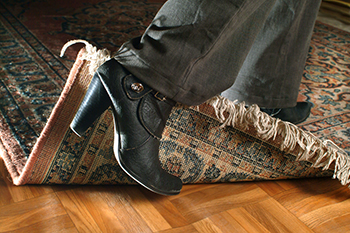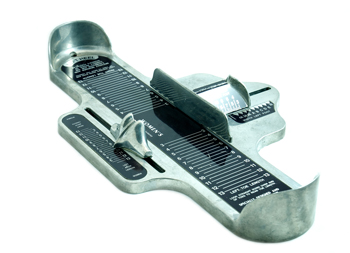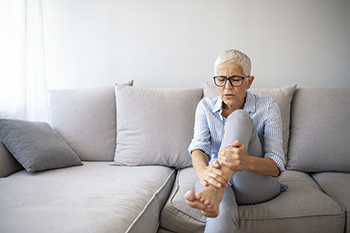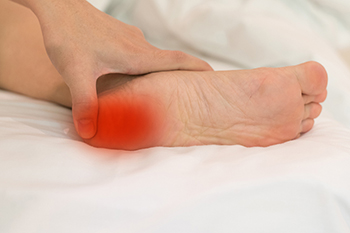Items filtered by date: August 2022
Effective Fall Prevention Methods

Research has indicated that approximately one in three Americans who are 65 or older will fall, which is a leading cause of hospitalization for adults in New York City. Many people develop a fear of falling, and this can be detrimental to completing daily chores and experiencing new activities. When people fall, their feet are often negatively affected. Ankles or toes may be broken, and this can cause severe pain and discomfort. There are simple prevention techniques that can be implemented to help prevent painful falling episodes. These can include incorporating gentle exercise and stretching routines into the daily regime, clearing clutter in the household, and improving lighting in the living area. Additionally, it is beneficial to have regular physical examinations performed, as this is helpful in monitoring existing medications. Glasses can be updated when the eyes are checked, and it is beneficial to have this done annually. Wearing shoes that fit correctly can be helpful in possibly preventing falls, and maintaining proper foot care is essential in having the feet feel good. Some people find it useful to have grab bars installed in the bath and toilet area, in addition to using a bathmat. If you would like to know about how to protect the feet and how to reduce the number of falls, please ask a podiatrist who can answer any questions you may have.
Preventing falls among the elderly is very important. If you are older and have fallen or fear that you are prone to falling, consult with Dr. Richard T. Bauer from Summit Foot & Ankle. Our doctor will assess your condition and provide you with quality advice and care.
Every 11 seconds, an elderly American is being treated in an emergency room for a fall related injury. Falls are the leading cause of head and hip injuries for those 65 and older. Due to decreases in strength, balance, senses, and lack of awareness, elderly persons are very susceptible to falling. Thankfully, there are a number of things older persons can do to prevent falls.
How to Prevent Falls
Some effective methods that older persons can do to prevent falls include:
- Enrolling in strength and balance exercise program to increase balance and strength
- Periodically having your sight and hearing checked
- Discuss any medications you have with a doctor to see if it increases the risk of falling
- Clearing the house of falling hazards and installing devices like grab bars and railings
- Utilizing a walker or cane
- Wearing shoes that provide good support and cushioning
- Talking to family members about falling and increasing awareness
Falling can be a traumatic and embarrassing experience for elderly persons; this can make them less willing to leave the house, and less willing to talk to someone about their fears of falling. Doing such things, however, will increase the likelihood of tripping or losing one’s balance. Knowing the causes of falling and how to prevent them is the best way to mitigate the risk of serious injury.
If you have any questions, please feel free to contact our office located in Latham, NY . We offer the newest diagnostic and treatment technologies for all your foot care needs.
Are You Suffering From Ingrown Toenails?
Many Aspects to Finding the Right Shoe Size

Research has shown that not all shoes are made the same. This may affect shoe size and can vary from one type of shoe to the other. People who sell shoes stress the importance of knowing what the width and flex point is. The flex point is where the shoe bends at its widest point and this may be obvious when the shoes are tried on. Additionally, it is wise to know what type of instep you have as this could rule out or confirm specific types of shoes to be worn. The type of material that the shoe is made of may help to decide your purchase. Materials like leather will break in differently from a mesh or canvas upper part of the shoe and will fit differently. It is suggested to try shoes on at the end of the day when the feet are at their largest. The most important thing to look for when trying new shoes on is the level of comfort. All shoes will fit differently so when you find a pair that fits your feet like Cinderella’s slipper, it may be wise to purchase them. If you would like additional tips about getting the right shoe size, please confer with a podiatrist.
Getting the right shoe size is an important part of proper foot health. Seek the assistance of Dr. Richard T. Bauer from Summit Foot & Ankle. Our doctor will provide the care you need to keep you pain-free and on your feet.
Getting the Right Shoe Size
There are many people who wear shoes that are the incorrect size, negatively affecting their feet and posture. Selecting the right shoes is not a difficult process, so long as you keep several things in mind when it comes to choosing the right pair.
- When visiting the shoe store, use the tools available to measure your foot.
- Be sure there is ‘wiggle room’. There should be about an inch between your toes and the tip of your shoes.
- Do not always assume you are the same size, as manufacturers run differently.
- Purchase shoes later in the day, as your feet swell as the day progresses.
- If a shoe is not comfortable, it is not suitable. Most shoes can’t be ‘broken in’, and comfort should be the ultimate goal when it comes to choosing the right pair of shoes
As our feet hold our body weight and keep us moving, it is important to treat them right. Picking the right pair of shoes can provide your feet comfort and mobility without pain.
If you have any questions, please feel free to contact our office located in Latham, NY . We offer the newest diagnostic and treatment technologies for all your foot care needs.
Dealing With Peripheral Neuropathy in the Feet

Peripheral neuropathy is the result of nerve damage to parts of the body other than the brain and spinal column. The peripheral nervous system sends signals to the feet and ankles. If the nerves are damaged, the messages are blocked. This can result in tingling, numbness, muscle cramps, and burning pain. Periods of extreme sensitivity can alternate with periods of numbness. Among the possible causes of peripheral neuropathy are traumatic injury, infections (shingles), genetics, exposure to toxins, increased age, and problems with the metabolism. One of the most common causes of peripheral neuropathy is as a side effect of diabetes. Unfortunately, peripheral neuropathy of the feet can result in additional problems. Sores and cuts may go undetected because of numbness or inability to detect hot or cold temperatures, especially on the soles of the feet. Wounds may go untreated and cause infection, which in turn can lead to ulcers. If you are experiencing symptoms of peripheral neuropathy, especially if you also are a diabetic, it is strongly suggested that you consult a podiatrist for a complete examination and possible treatment options.
Neuropathy
Neuropathy can be a potentially serious condition, especially if it is left undiagnosed. If you have any concerns that you may be experiencing nerve loss in your feet, consult with Dr. Richard T. Bauer from Summit Foot & Ankle. Our doctor will assess your condition and provide you with quality foot and ankle treatment for neuropathy.
What Is Neuropathy?
Neuropathy is a condition that leads to damage to the nerves in the body. Peripheral neuropathy, or neuropathy that affects your peripheral nervous system, usually occurs in the feet. Neuropathy can be triggered by a number of different causes. Such causes include diabetes, infections, cancers, disorders, and toxic substances.
Symptoms of Neuropathy Include:
- Numbness
- Sensation loss
- Prickling and tingling sensations
- Throbbing, freezing, burning pains
- Muscle weakness
Those with diabetes are at serious risk due to being unable to feel an ulcer on their feet. Diabetics usually also suffer from poor blood circulation. This can lead to the wound not healing, infections occurring, and the limb may have to be amputated.
Treatment
To treat neuropathy in the foot, podiatrists will first diagnose the cause of the neuropathy. Figuring out the underlying cause of the neuropathy will allow the podiatrist to prescribe the best treatment, whether it be caused by diabetes, toxic substance exposure, infection, etc. If the nerve has not died, then it’s possible that sensation may be able to return to the foot.
Pain medication may be issued for pain. Electrical nerve stimulation can be used to stimulate nerves. If the neuropathy is caused from pressure on the nerves, then surgery may be necessary.
If you have any questions, please feel free to contact our office located in Latham, NY . We offer the newest diagnostic and treatment technologies for all your foot care needs.
Arthritis May Cause Toe Pain

Pain, swelling, and stiffness often accompany arthritis in the feet. Many people have their toes affected by arthritis and it can be difficult to walk. Additionally, there may be a bump that forms as a result of the joints rubbing together and the toes may curl. The most common form of arthritis is known as osteoarthritis and it affects the cartilage between the joints generally causing pain and discomfort. The condition that is known as gout can cause pain in the big toe and comes from having excess uric acid in the bloodstream. This can cause crystals to lodge between the joints in the big toe and can cause debilitating pain. An autoimmune disease can cause psoriatic arthritis and typically affects the toes. Another form of toe pain can come from having an infection within the joint and this is referred to as infectious arthritis. Mild relief may be found when the shoes that are worn fit properly and it is advised to refrain from wearing high heels. If you have pain in your toes, please consult with a podiatrist who can effectively diagnose arthritis in the feet as well as offer correct treatment advice.
Arthritis can be a difficult condition to live with. If you are seeking treatment, contact Dr. Richard T. Bauer from Summit Foot & Ankle. Our doctor can provide the care you need to keep you pain-free and on your feet.
Arthritic Foot Care
Arthritis is a term that is commonly used to describe joint pain. The condition itself can occur to anyone of any age, race, or gender, and there are over 100 types of it. Nevertheless, arthritis is more commonly found in women compared to men, and it is also more prevalent in those who are overweight. The causes of arthritis vary depending on which type of arthritis you have. Osteoarthritis for example, is often caused by injury, while rheumatoid arthritis is caused by a misdirected immune system.
Symptoms
- Swelling
- Pain
- Stiffness
- Decreased Range of Motion
Arthritic symptoms range in severity, and they may come and go. Some symptoms stay the same for several years but could potentially get worse with time. Severe cases of arthritis can prevent its sufferers from performing daily activities and make walking difficult.
Risk Factors
- Occupation – Occupations requiring repetitive knee movements have been linked to osteoarthritis
- Obesity – Excess weight can contribute to osteoarthritis development
- Infection – Microbial agents can infect the joints and trigger arthritis
- Joint Injuries – Damage to joints may lead to osteoarthritis
- Age – Risk increases with age
- Gender –Most types are more common in women
- Genetics – Arthritis can be hereditary
If you suspect your arthritis is affecting your feet, it is crucial that you see a podiatrist immediately. Your doctor will be able to address your specific case and help you decide which treatment method is best for you.
If you have any questions, please feel free to contact our office located in Latham, NY . We offer the newest diagnostic and treatment technologies for all your foot care needs.
Discovering the Source of Your Heel Pain

Heel pain is a common affliction that podiatrists treat on a daily basis. They see many different forms of heel pain emanating from injuries to soft tissues and other structures, breaks in bones, and arthritis. Soft tissue inflammatory conditions that cause heel pain include plantar fasciitis (inflammation of the plantar fascia tissue on the sole of the foot), Achilles tendonitis (inflammation of the Achilles tendon at the back of the ankle that connects the calf muscles to the heel), ligament sprains and muscles strains near the heel, and bursitis (inflammation of the bursa sac between the heel and the Achilles tendon). A fractured heel can vary from a small crack to a full break in the bone, and cause a great deal of heel pain. There are also different forms of arthritis, such as ankylosing spondylitis and reactive arthritis, which can cause pain and tightness in the heel. To have your heel pain properly diagnosed and treated, make an appointment with a podiatrist who can help devise an effective treatment plan to address your specific condition.
Many people suffer from bouts of heel pain. For more information, contact Dr. Richard T. Bauer of Summit Foot & Ankle. Our doctor can provide the care you need to keep you pain-free and on your feet.
Causes of Heel Pain
Heel pain is often associated with plantar fasciitis. The plantar fascia is a band of tissues that extends along the bottom of the foot. A rip or tear in this ligament can cause inflammation of the tissue.
Achilles tendonitis is another cause of heel pain. Inflammation of the Achilles tendon will cause pain from fractures and muscle tearing. Lack of flexibility is also another symptom.
Heel spurs are another cause of pain. When the tissues of the plantar fascia undergo a great deal of stress, it can lead to ligament separation from the heel bone, causing heel spurs.
Why Might Heel Pain Occur?
- Wearing ill-fitting shoes
- Wearing non-supportive shoes
- Weight change
- Excessive running
Treatments
Heel pain should be treated as soon as possible for immediate results. Keeping your feet in a stress-free environment will help. If you suffer from Achilles tendonitis or plantar fasciitis, applying ice will reduce the swelling. Stretching before an exercise like running will help the muscles. Using all these tips will help make heel pain a condition of the past.
If you have any questions please contact our office located in Latham, NY . We offer the newest diagnostic and treatment technologies for all your foot and ankle needs.

